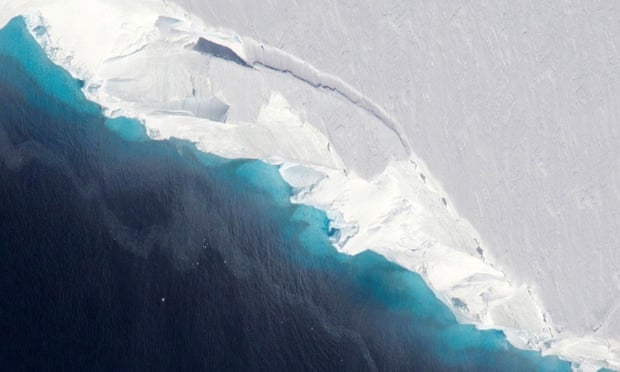Researchers working as part of a Nasa-led study found the cavern, which they said was 300 metres tall and two-thirds the size of Manhattan, at the bottom of the massive Thwaites glacier.
The space is big enough to have contained 14bn tonnes of ice and most of that ice has melted during the past three years.
In a paper published in Science Advances, the scientists said the rapid change in the ice was “unexpected” at some points on the glacier.
The researchers found the cavity using Italian and German satellites and ice-penetrating radar from Nasa’s Operation IceBridge, which uses research aircraft to monitor changes in polar ice.
“[The size of] a cavity under a glacier plays an important role in melting,” said the study’s lead author, Pietro Milillo, who is scientist at the Nasa Jet Propulsion Laboratory. “As more heat and water get under the glacier, it melts faster.”
But Milillo told the Guardian the size of the underwater cavity was not the main concern because the 14bn tonnes it released were already underwater and so would not contribute to sea level rise. The important aspect of the paper, he said, was what it revealed about the interaction between sea and ice.
Jeremie Mouginot, a co-author of the paper and a research scientist at the Université Grenoble Alpes, said ocean water was filling a widening gap between the floating ice shelf and the bedrock.
Thwaites, he said, was a 120km-wide “monster glacier” that is continuing its retreat with huge future implications, because it could potentially add 0.6 metres to rising seas.
Thwaites also supports neighbouring glaciers that, if they melted, would increase sea levels by an additional 2.44 metres, threatening coastal communities worldwide.
Mouginot said further studies would be needed on where and how Thwaites will decline. “The current question is not if the glaciers will retreat but at which pace.”
There are already new investigations of Thwaites under way, including one by a UK team, as well as studies of other Antarctic regions.
The hole is on the glacier’s western side and has been melting at a rate of about 0.6 to 0.8km a year since 1992, a rate that while stable was “extremely high”, Nasa said.
Eric Rignot, a co-author of the study, said understanding how warming oceans were melting the glacier away was “essential to project its impact on sea level rise in the coming decades”.
“We have suspected for years that Thwaites was not tightly attached to the bedrock beneath it,” he said.
More about: #Antarctic-glacier
















































